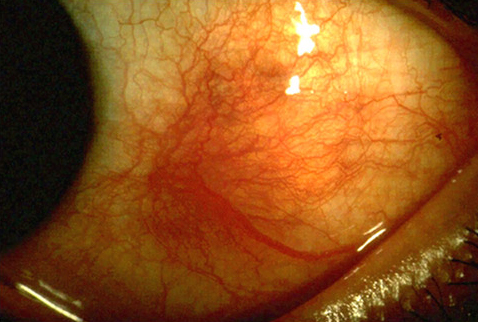Eye Care > Diseases of the Eye > Scleritis
Scleritis is an inflammatory disease that affects the conjunctiva, sclera, and episclera (the connective tissue between the conjunctiva and sclera). It is associated with underlying systemic disease in about half of the cases. The diagnosis of scleritis may lead to the detection of underlying systemic disease. Rarely, scleritis is associated with an infectious problem.
The affected area of the sclera may be confined to small nodules, or it may cause generalized inflammation. Necrotizing scleritis, a more rare, serious type, causes thinning of the sclera. Severe cases of scleritis may also involve inflammation of other ocular tissues.
Scleritis affects women more frequently then men. It most frequently occurs in those who are in their 40’s and 50’s. The problem is usually confined to one eye, but may affect both.

Along with visual acuity testing, measurement of intraocular pressure, slit lamp examination, and ophthalmoscopy, the eye care practitioner may request a physician to order blood tests to rule out diseases affecting the body. If involvement of the back of the eye is suspected, the physician may order imaging tests such as CT Scan, MRI, or ultrasonography of the eye.
Scleritis is treated with oral steroid and non-steroidal anti-inflammatory medication to reduce inflammation. Eye drops alone do not provide adequate treatment. In very severe cases of necrotizing scleritis, surgery may be required to graft scleral or corneal tissue over the area of thinned sclera.
| Cookie | Duration | Description |
|---|---|---|
| cookielawinfo-checkbox-analytics | 11 months | This cookie is set by GDPR Cookie Consent plugin. The cookie is used to store the user consent for the cookies in the category "Analytics". |
| cookielawinfo-checkbox-functional | 11 months | The cookie is set by GDPR cookie consent to record the user consent for the cookies in the category "Functional". |
| cookielawinfo-checkbox-necessary | 11 months | This cookie is set by GDPR Cookie Consent plugin. The cookies is used to store the user consent for the cookies in the category "Necessary". |
| cookielawinfo-checkbox-others | 11 months | This cookie is set by GDPR Cookie Consent plugin. The cookie is used to store the user consent for the cookies in the category "Other. |
| cookielawinfo-checkbox-performance | 11 months | This cookie is set by GDPR Cookie Consent plugin. The cookie is used to store the user consent for the cookies in the category "Performance". |
| viewed_cookie_policy | 11 months | The cookie is set by the GDPR Cookie Consent plugin and is used to store whether or not user has consented to the use of cookies. It does not store any personal data. |